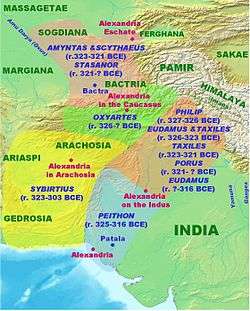Seleucid–Mauryan war
| Seleucid–Mauryan War | |||||||
|---|---|---|---|---|---|---|---|
 Alexander the Great's Satrapies in Northern India. | |||||||
| |||||||
| Belligerents | |||||||
| Maurya Empire | Seleucid Empire | ||||||
| Commanders and leaders | |||||||
| Chandragupta Maurya | Seleucus I Nicator | ||||||
| Strength | |||||||
|
600,000 infantry 30,000 cavalry, 9,000 war elephants[1] | 200,000 infantry, 40,000 cavalry, 60,000 allies | ||||||
| Casualties and losses | |||||||
| unknown | unknown | ||||||
In 305 BCE, Indian Emperor Chandragupta Maurya of the Maurya Empire led a series of campaigns to retake the satrapies left behind by Alexander the Great when he returned westwards. Seleucus I Nicator fought to defend these territories, but both sides made peace in 303 BCE. The treaty ended the Seleucid–Mauryan war and allowed Chandragupta control of the regions he was warring for while Seleucus was given 500 highly valued war elephants in exchange.
Background

Chandragupta Maurya established himself as ruler of Magadha around 321 BCE. He decided to conquer the Nanda Dynasty, rulers at the time of the Gangetic Plain. He fought the empire for eleven years with successful guerrilla campaigns, and captured the Nanda capital of Pataliputra. This led to the fall of the empire and the eventual creation of the Maurya Empire under Emperor Chandragupta Maurya.
The states of the Indus Valley and modern Afghanistan were part of the Empire of Alexander the Great. When Alexander died, the Wars of the Diadochi ("Successors") split his empire apart; as his generals warred over control of the throne. In the eastern territories one of these, Seleucus Nicator, was taking control and creating the beginnings of the Seleucid Empire. This included Alexander's conquests along the Indus Valley.
The emerging and expanding Mauryan Empire now came into conflict over the Indus Valley with the efforts of Seleucus I Nicator to hold these territories.
War
Little is known of the campaign, in which Chandragupta fought with Seleucus over the Indus Valley and the region of Gandhara, a very wealthy kingdom that had submitted decades earlier to Alexander the Great. The Mauryans seem to have got the better of the fighting, though no record survives. The region fell to the Mauryans; and Chandragupta also took over Kashmir and the Hindu Kush. At the same time, Chandragupta expanded into the Deccan.[2] Chandragupta took over the Punjab also, and by 303 BCE he had taken over Eastern Afghanistan and everything in between. However, whether or not these territories were acquired by subsequent treaty with Seleucus or by military conquest is also unknown.
Seleucus' focus was not in the east, but in the west, where his greatest enemy, Antigonus I Monophthalmus, was attempting to crush all of his rivals and take complete control of Alexander's legacy. To end the losing war against the Mauryan Empire and focus his attention in the west, Seleucus negotiated a peace and ceded Alexander's Indian territories to Chandragupta. According to Roman historian Appian Seleucus also formed a "marriage relationship" with Chandragupta received 500 war elephants, which would prove decisive in the conflict ahead, culminating in the Battle of Ipsus. Although the nature of the "marriage relationship" is unclear, some authors have speculated that Seleucus married his daughter to Chandragupta and, in return as dowry, Seleucus received the elephants.[3] Chandragupta would thus have had a Greek wife, who therefore may have been the grandmother of later Emperor Ashoka.[4][5]
Always lying in wait for the neighboring nations, strong in arms and persuasive in council, he acquired Mesopotamia, Armenia, 'Seleucid' Cappadocia, Persis, Parthia, Bactria, Arabia, Tapouria, Sogdia, Arachosia, Hyrcania, and other adjacent peoples that had been subdued by Alexander, as far as the river Indus, so that the boundaries of his empire were the most extensive in Asia after that of Alexander. The whole region from Phrygia to the Indus was subject to Seleucus. He crossed the Indus and waged war with Sandrocottus [Maurya], king of the Indians, who dwelt on the banks of that stream, until they came to an understanding with each other and contracted a marriage relationship. Some of these exploits were performed before the death of Antigonus and some afterward.
The peace was negotiated by the Greek envoy, Megasthenes. He made several journeys into the Mauryan Empire, chronicling his journeys.
Aftermath
Emperor Chandragupta converted to Jainism and abdicated his throne as part of his faith around 298 BCE. His empire included most of India (the southern-most regions were left unconquered). He was succeeded by his son, Bindusara. Mysore was taken by Bindusara, the empire reaching its expansion zenith.
For the Seleucids, the war affected the Wars of the Diadochi in the west. With the elephant force acquired from the Maurya, Seleucus was able to defeat his rival, Antigonas, at the Battle of Ipsus. Adding Antigonas' territories to his own, Seleucus would found the Seleucid Empire; which endured as a great power in the Mediterranean and the Middle East till 64 BCE.
Notes
References
- Majumdar, Ramesh Chandra (2003) [1952], Ancient India, Motilal Banarsidass, ISBN 81-208-0436-8